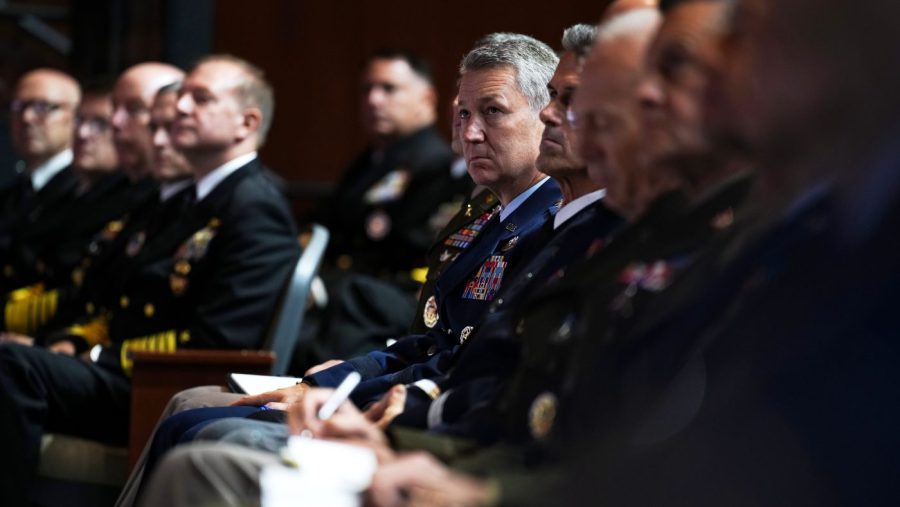Climate change threatens national security — how are the generals responding?

America’s top military officers sat in stony silence last month when President Trump addressed them at Quantico. Those who spoke their minds risked being stripped of their rank.
Yet America’s military and intelligence leaders know that Trump is jeopardizing national security by dismissing climate change as a hoax. Over the decades, security and intelligence analysts have repeatedly warned that global warming acts as a “threat multiplier.”
Scientists have underscored that conclusion. As Kevin Trenberth at the National Center for Atmospheric Research recently explained: “By the time the global temperatures have reached 2 degrees Celsius above pre-industrial temperatures, scheduled now for the 2050s, not only will there be continual extreme weather events … the result will be widespread environmental refugees, exacerbating tensions and regional conflicts that could explode to encompass many countries.”
Those countries include the U.S. At a minimum, America’s military forces will be diverted to conduct humanitarian missions in other nations destabilized by climate impacts. In the worst case, the U.S. could be drawn into wars within and between other countries.
Researchers at Stanford University pointed this out six years ago. They estimated that the influence of climate change in conflicts is “expected to increase dramatically,” more than doubling if the planet’s temperature rises 2 degrees Celsius above pre-industrial levels, the upper limit set in the Paris Climate Agreement.
However, that is the optimistic scenario. Under current policies, the world will warm as much as 2.9 degrees by 2100, according to Climate Action Tracker.
Trump is ignoring a long series of warnings by the government’s top military and intelligence experts. In 2007, the Military Advisory Board at the Center for Naval Analysis was the first to use the “threat multiplier” label. It said that global warming “poses a serious threat to America’s national security,” threatens to destabilize some of the world’s most volatile regions, and would “add to tensions even in stable regions.”
In 2012, the Department of Homeland Security warned, “The impacts of climate change could directly affect the Nation’s critical infrastructure.”
In 2014, the Department of Defense reported, “A changing climate will have real impacts on our military and the way it executes its missions. … Climate change will affect the Department of Defense’s ability to defend the Nation and poses immediate risks to U.S. national security.”
In 2015, the White House National Security Strategy warned, “Climate change is an urgent and growing threat to our national security, contributing to increased natural disasters, refugee flows, and conflicts over basic resources like food and water.”
In 2016, the National Intelligence Council issued a new advisory: “Climate change is projected to produce more intense and frequent extreme weather events, multiple weather disturbances, along with broader climatological effects, such as sea level rise. These are almost certain to have significant direct and indirect social, economic, political, and security implications during the next 20 years.”
Climate change poses a direct threat to many of the U.S. military’s 750 installations across 80 countries. Many are within reach of intensifying coastal storms and sea-level rise, and are located in countries expected to be hit hard by climate impacts.
In 2018, the Department of Defense surveyed U.S. military infrastructure worldwide and found that half of the 3,500 sites had been affected by extreme weather and other climate-related risks. “Our warfighters require bases from which to deploy, on which to train, or to live when they are not deployed. If extreme weather makes our critical facilities unusable or necessitates costly or manpower-intensive workarounds, that is an unacceptable impact,” the department concluded.
A year later, it reported that floods, droughts or wildfires already threatened 74 of its 79 most important installations.
Climate change need not be the principal cause of armed conflict. Instead, it is a catalyst where other instability exists. For that reason, analysts say that foreign aid is important for improving socioeconomic conditions in vulnerable countries.
“Unless we invest more in supporting those communities that are on the front lines of the climate emergency, to better adapt and prepare for the unavoidable surge in extreme weather events, then there is likely to be an increase in the preconditions for conflict and violence to take place,” the National Intelligence Council concluded.
Yet, Trump mocks and denies climate change. He has defunded climate science, shut down USAID, cut billions from foreign aid, withdrawn America from the Paris Climate Agreement, accelerated U.S. production of fossil fuels, used the threat of trade tariffs to extort other countries into buying U.S. oil and gas, and wasted the armed force’s resources by deploying them against Democrat-run states and cities to fight a nonexistent “enemy from within.” Yet, in terms of national security, the “enemy within” is within the White House.
How should America’s top military officers and intelligence officials respond? Certainly not with stony silence.
William S. Becker is co-editor of and a contributor to “Democracy Unchained: How to Rebuild Government for the People,” and contributor to Democracy in a Hotter Time, named by the journal Nature as one of 2023’s five best science books. He previously served as a senior official in the Wisconsin Department of Justice and is currently executive director of the Presidential Climate Action Project, a nonpartisan climate policy think tank unaffiliated with the White House.